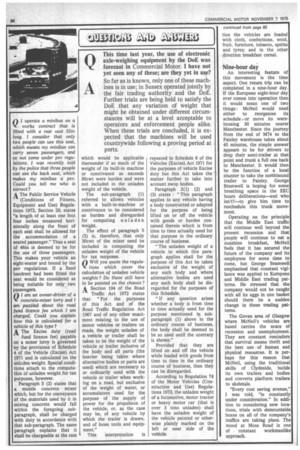Q I operate a minibus on a NC works contract that
Page 88

If you've noticed an error in this article please click here to report it so we can fix it.
is fitted with a rear seat 521n long. I consider that only two people can use this seat, which means my minibus can carry seven passengers, and so not come under psv regulations. / was recently told by the police that three people can use the back seat, which makes my minibus a psv. Could you tell me who is correct ? A The Public Service Vehicle (Conditions of Fitness, Equipment and Use) Regulations 1972, Section 20, states "a length of at least one foot four inches measured horizontally along the front of each seat shall be allowed for the accommodation of a seated passenger." Thus a seat of 48in is deemed to be for the use of three passengers. This makes your vehicle an eight-seater and bound by the psv regulations. If a fixed handrest had been fitted the seat would be considered as being suitable for only two passengers.
Q/ am an owner-driver of a concrete-mixer lorry and I am puzzled about the road fund licence fee which I am charged. Could you explain how this is calculated for a vehicle of this type ? A The Excise duty (road fund licence fee) payable on a mixer lorry is governed by the provisions of Schedule 4 of the Vehicle (Excise) Act 1971 and is calculated on the unladen weight. Special conditions attach to the computation of unladen weight for tax purposes, however.
Paragraph 5 (2) states that a mobile concrete mixer which, but for the conveyance of the materials used by it in mixing concrete would fall within the foregoing subparagraph, shall be charged with duty in accordance with that sub-paragraph. The same paragraph explains that it shall be chargeable at the rate which would be applicable thereunder if so much of the weight of its built-in machine or contrivance as exceeds 30cwt were burden and were not included in the unladen weight of the vehicle.
The sub-paragraph (1) referred to allows vehicles with a built-in-machine or contrivance to be considered as burden and disregarded for computing unladen weight.
The effect of paragraph 5 (2) is, therefore, that only 30cwt of the mixer need be included in computing the unladen weight of the vehicle for tax Purposes.
QWill you quote the regulations which cover the calculation of unladen vehicle weights? Do these still have to be painted on the chassis? A Section 194 of the Road Traffic Act 1972 states that "For the purposes of this Act and of the Road Traffic Regulation Act 1967 and of any other enactment relating to the use of motor vehicles or trailers on roads, the weight unladen of a vehicle or trailer shall be taken to be the weight of the vehicle or trailer inclusive of the body and all parts (the heavier being taken where alternative bodies or parts are used) which are necessary to or ordinarily used with the vehicle or trailer when working on a road, but exclusive of the weight of water, or accumulators used for the purpose of the supply of power for the propulsion of the vehicle, or, as the case may be, of any vehicle by which the trailer is drawn, and of loose tools and equipment."
This interpretation is repeated in Schedule 6 of the Vehicles (Excise) Act 1971 for the purposes of vehicle Excise duty but this Act takes the matter further to take into account swop bodies.
Paragraph 2(1) (2) and (3) states : "This paragraph applies to any vehicle having a body constructed or adapted for the purpose of being lifted on or off the vehicle with goods or burden contained therein which is from time to time actually used for that purpose in the ordinary course of business.
"The unladen weight of a vehicle to which this paragraph applies shall for the purpose of this Act be taken exclusive of the weight of any such body and where alternative bodies are used any such body shall be disregarded for the purposes of this Schedule.
"If any question arises whether a body is from time to time actually used for the purpose mentioned in subparagraph (1) above in the ordinary course of business, the body shall be deemed to be so used until the contrary is shown."
Provided that they are lifted on and off the vehicle while loaded with goods from time to time in the ordinary course of business, then they can be disregarded.
According to Regulation 74 of the Motor Vehicles (Construction and Use) Regulations 1973, the unladen weight of a locomotive, motor tractor or heavy motor car (that is over 3 tons unladen) shall have the unladen weight of the vehicle painted or otherwise plainly marked on the left or near side of the vehicle.
















































































































































































































